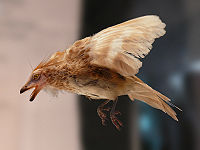La Huérguina Formation: Difference between revisions
Appearance
Content deleted Content added
Magioladitis (talk | contribs) m clean up using AWB (10515) |
Tags: Mobile edit Mobile web edit |
||
| Line 140: | Line 140: | ||
|- |
|- |
||
|} |
|} |
||
Many fish and lizards also have been found. |
|||
==See also== |
==See also== |
||
Revision as of 17:20, 13 July 2015
| Calizas de La Huergina Formation | |
|---|---|
| Stratigraphic range: Early Cretaceous | |
| Type | Geological formation |
| Location | |
| Region | Europe |
The Calizas de La Huérgina Formation (also known as the Una Formation) is a geological formation in Spain whose strata date back to the Early Cretaceous. Dinosaur remains are among the fossils that have been recovered from the formation.[1]
Vertebrate paleofauna
This section needs expansion. You can help by adding to it. (December 2008) |
Color key
|
Notes Uncertain or tentative taxa are in small text; |
| Dinosaurs reported from the Calizas de La Huergina Formation | ||||||
|---|---|---|---|---|---|---|
| Genus | Species | Location | Stratigraphic position | Material | Notes | Images |
|
C. corcovatus[2] |
"Nearly complete and articulated skeleton." |
  | ||||
|
C. lacustris[3] |
"Postcranial skeleton."[4] |
|||||
|
E. hoyasi[3] |
"Thoracic region and forelimbs."[4] |
|||||
|
Indeterminate[5] |
||||||
|
E. olcadesorum |
||||||
|
I. romerali[3] |
"Postcranial skeleton."[6] |
|||||
|
I. Bernissartensis[3] |
||||||
|
P. polyodon[3] |
"Skull and partial skeleton."[7] |
|||||
|
Indeterminate[8] |
||||||
|
Indeterminate[9] |
||||||
Many fish and lizards also have been found.
See also
Footnotes
- ^ Weishampel, David B; et al. (2004). "Dinosaur distribution (Early Cretaceous, Europe)." In: Weishampel, David B.; Dodson, Peter; and Osmólska, Halszka (eds.): The Dinosauria, 2nd, Berkeley: University of California Press. Pp. 556-563. ISBN 0-520-24209-2.
- ^ a b Ortega F., Escaso, F. and Sanz, J.L. (2010). "A bizarre, humped Carcharodontosauria (Theropoda) from the Lower Cretaceous of Spain." Nature, 467: 203-206. doi:10.1038/nature09181 PMID 20829793
- ^ a b c d e f g h i j "15.9 Provincia de Quenca, Spain; 4. Calizas de La Huergina Formation," in Weishampel, et al. (2004). Pages 561-562.
- ^ a b "Table 11.1," in Weishampel, et al. (2004). Page 212.
- ^ a b Listed as "cf. Euronychodon sp." in "15.9 Provincia de Quenca, Spain; 4. Calizas de La Huergina Formation," in Weishampel, et al. (2004). Page 561.
- ^ "Table 11.1," in Weishampel, et al. (2004). Page 213.
- ^ "Table 6.1," in Weishampel, et al. (2004). Page 138.
- ^ a b Listed as "cf. Paranychodon sp." in "15.9 Provincia de Quenca, Spain; 4. Calizas de La Huergina Formation," in Weishampel, et al. (2004). Page 561.
- ^ a b Listed as "cf. Ricardoestesia sp." in "15.9 Provincia de Quenca, Spain; 4. Calizas de La Huergina Formation," in Weishampel, et al. (2004). Page 561.
References
- Weishampel, David B.; Dodson, Peter; and Osmólska, Halszka (eds.): The Dinosauria, 2nd, Berkeley: University of California Press. 861 pp. ISBN 0-520-24209-2.
